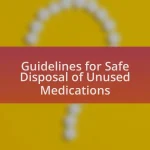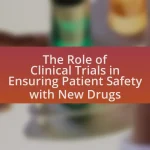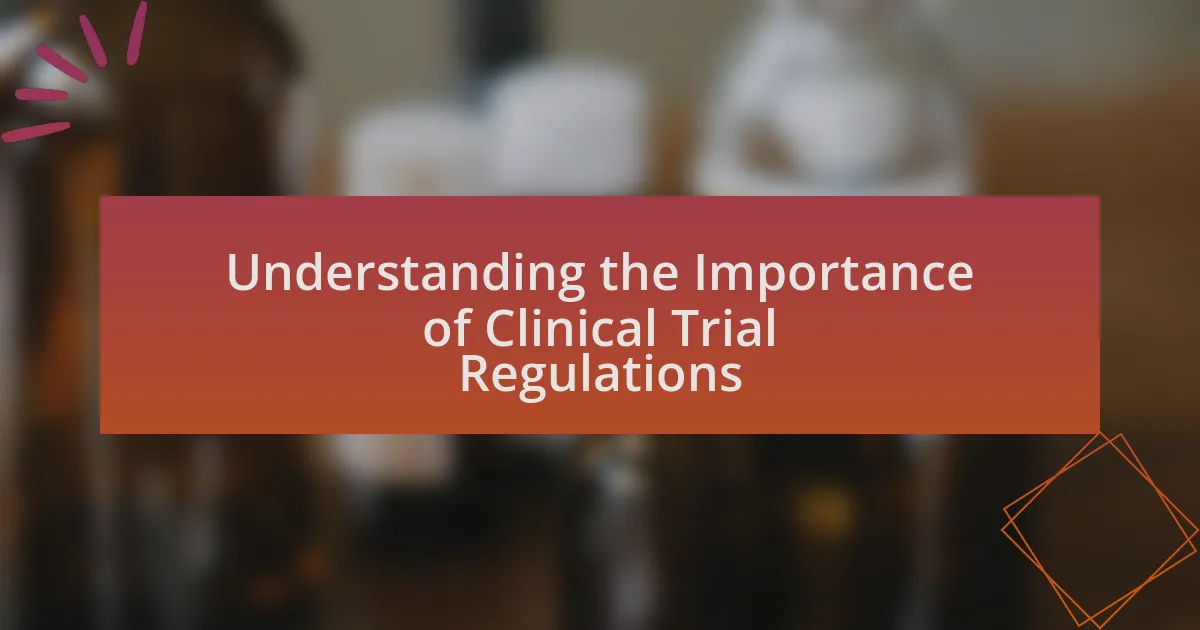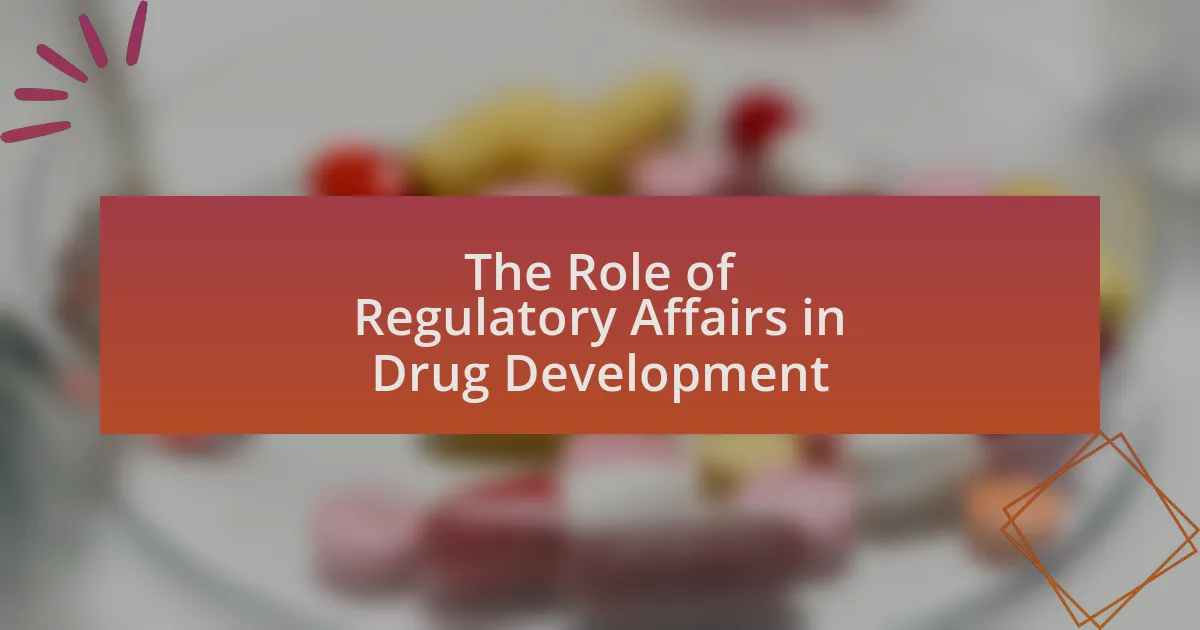The article focuses on strategies for successful regulatory submissions in the pharmaceutical industry, emphasizing the importance of thorough preparation, comprehensive documentation, and effective communication with regulatory agencies. It outlines how regulatory requirements differ across regions, particularly between the United States and Europe, and discusses the specific regulations governing pharmaceutical submissions. Key stages of the submission process, common challenges, and best practices for enhancing submission quality are also examined. Additionally, the article highlights the role of stakeholder engagement and the impact of regulatory changes on submission outcomes, providing insights into tools and technologies that can streamline the submission process.
What are the key strategies for successful regulatory submissions in the pharmaceutical industry?

Key strategies for successful regulatory submissions in the pharmaceutical industry include thorough preparation, comprehensive documentation, and effective communication with regulatory agencies. Thorough preparation involves understanding regulatory requirements and guidelines specific to the target market, which can significantly reduce the likelihood of submission delays. Comprehensive documentation ensures that all necessary data, including clinical trial results and safety information, is accurately presented, aligning with the expectations of regulatory bodies like the FDA or EMA. Effective communication with regulatory agencies fosters a collaborative relationship, allowing for clarification of requirements and timely feedback, which can enhance the overall submission process. These strategies are supported by the fact that successful submissions often result from meticulous planning and proactive engagement with regulators, as evidenced by industry reports indicating that well-prepared submissions have higher approval rates.
How do regulatory requirements vary across different regions?
Regulatory requirements vary significantly across different regions, influenced by local laws, cultural norms, and healthcare systems. For instance, the U.S. Food and Drug Administration (FDA) has stringent guidelines for drug approval, emphasizing clinical trial data and post-market surveillance, while the European Medicines Agency (EMA) requires a comprehensive risk management plan and adherence to the European Union’s pharmacovigilance regulations. In contrast, countries in Asia, such as Japan, have unique requirements that include the need for local clinical trials and specific documentation in Japanese. These differences necessitate tailored strategies for regulatory submissions in the pharmaceutical industry to ensure compliance and successful market entry.
What are the specific regulations in the United States?
The specific regulations in the United States governing the pharmaceutical industry include the Federal Food, Drug, and Cosmetic Act (FDCA), which establishes the framework for the approval and marketing of drugs. The Food and Drug Administration (FDA) enforces these regulations, requiring that new drugs undergo rigorous testing for safety and efficacy before approval. Additionally, the Drug Enforcement Administration (DEA) regulates controlled substances, ensuring compliance with laws regarding the manufacture, distribution, and prescription of these drugs. The Biologics Control Act also governs the approval of biological products. These regulations are designed to protect public health and ensure that pharmaceutical products meet established safety and effectiveness standards.
How do European regulations differ from those in the US?
European regulations differ from those in the US primarily in their approach to drug approval and safety standards. In Europe, the European Medicines Agency (EMA) emphasizes a more stringent pre-market evaluation process, requiring comprehensive clinical data and risk-benefit assessments before granting marketing authorization. In contrast, the US Food and Drug Administration (FDA) allows for more flexibility, often permitting accelerated approval pathways based on surrogate endpoints. Additionally, European regulations mandate post-marketing surveillance and risk management plans, while the US system focuses more on pre-approval data. This fundamental difference in regulatory philosophy impacts the strategies pharmaceutical companies must adopt for successful submissions in each region.
Why is understanding the submission process critical for success?
Understanding the submission process is critical for success because it directly influences the likelihood of regulatory approval for pharmaceutical products. A thorough grasp of the submission process enables companies to prepare comprehensive and accurate documentation, which is essential for meeting regulatory requirements. For instance, the U.S. Food and Drug Administration (FDA) has specific guidelines that must be followed for New Drug Applications (NDAs); failure to adhere to these can result in delays or rejections. Moreover, research indicates that companies with a clear understanding of the submission process experience a 30% higher approval rate on their first submission compared to those that do not. This highlights the importance of strategic planning and execution in navigating complex regulatory landscapes.
What are the stages of the regulatory submission process?
The stages of the regulatory submission process include preclinical research, clinical trials, submission of the application, review by regulatory authorities, and post-marketing surveillance. Preclinical research involves laboratory and animal studies to assess safety and efficacy. Clinical trials are conducted in phases to evaluate the drug’s effects on humans. The submission of the application, such as a New Drug Application (NDA) or Biologics License Application (BLA), is then made to regulatory bodies like the FDA. Following submission, regulatory authorities review the application for compliance with safety and efficacy standards. Finally, post-marketing surveillance monitors the drug’s performance in the general population to identify any long-term effects.
How can a well-structured submission impact approval timelines?
A well-structured submission can significantly reduce approval timelines by enhancing clarity and facilitating efficient review processes. Regulatory agencies prioritize submissions that are organized, comprehensive, and easy to navigate, which allows reviewers to quickly locate essential information and assess compliance with regulatory requirements. For instance, a study by the Tufts Center for the Study of Drug Development found that submissions with clear formatting and logical organization can lead to a 20% reduction in review time. This efficiency not only accelerates the approval process but also minimizes the likelihood of requests for additional information, which can further delay timelines.
What role does communication play in regulatory submissions?
Communication is essential in regulatory submissions as it ensures clarity, transparency, and compliance with regulatory requirements. Effective communication facilitates the exchange of critical information between pharmaceutical companies and regulatory authorities, which is vital for the approval process. For instance, clear documentation and timely responses to queries can significantly reduce review times and enhance the likelihood of successful submissions. Studies have shown that organizations with robust communication strategies experience fewer delays and rejections in their submissions, highlighting the importance of maintaining open lines of dialogue throughout the regulatory process.
How can effective communication with regulatory agencies enhance submissions?
Effective communication with regulatory agencies enhances submissions by ensuring clarity, reducing misunderstandings, and facilitating timely feedback. Clear communication allows pharmaceutical companies to present their data and rationale effectively, which can lead to quicker reviews and approvals. For instance, according to the FDA’s guidance on communication, engaging in early and ongoing dialogue can help identify potential issues before formal submission, thereby streamlining the process. This proactive approach not only improves the quality of submissions but also fosters a collaborative relationship with regulators, ultimately leading to more efficient regulatory pathways.
What are best practices for maintaining transparency during the process?
Best practices for maintaining transparency during the regulatory submission process in the pharmaceutical industry include clear communication, regular updates, and comprehensive documentation. Clear communication ensures that all stakeholders, including regulatory bodies and internal teams, understand the submission’s progress and any challenges encountered. Regular updates, such as status reports and meetings, foster trust and keep everyone informed about timelines and expectations. Comprehensive documentation, including detailed records of data, methodologies, and decision-making processes, provides a transparent account of the submission’s development and supports regulatory review. These practices are essential for building credibility and facilitating smoother interactions with regulatory authorities.
What are the common challenges faced during regulatory submissions?
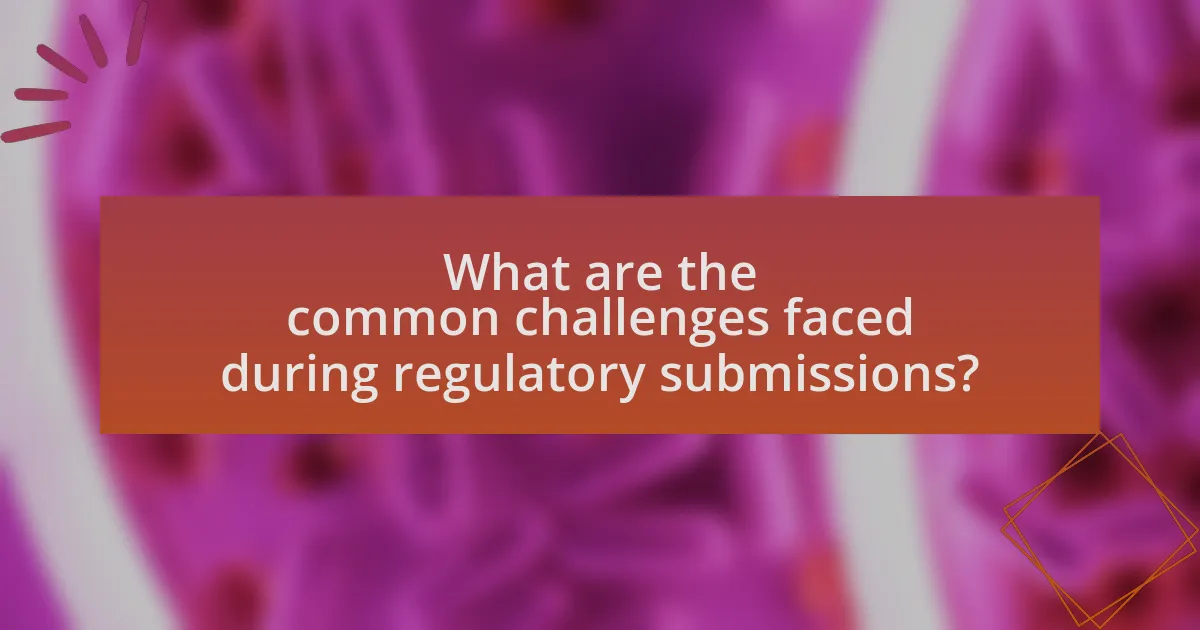
Common challenges faced during regulatory submissions include incomplete documentation, lack of clarity in regulatory requirements, and delays in data collection. Incomplete documentation can lead to rejection or requests for additional information, which prolongs the submission process. Regulatory requirements often vary by region, creating confusion and necessitating thorough understanding and compliance. Delays in data collection, often due to logistical issues or resource constraints, can hinder timely submissions. These challenges are well-documented in industry reports, highlighting the need for meticulous planning and coordination to navigate the regulatory landscape effectively.
How can incomplete data affect submission outcomes?
Incomplete data can significantly hinder submission outcomes by leading to regulatory rejections or delays. Regulatory agencies require comprehensive and accurate information to assess the safety and efficacy of pharmaceutical products. For instance, missing clinical trial data can result in an inability to demonstrate the product’s effectiveness, which is critical for approval. According to a study published in the Journal of Pharmaceutical Sciences, submissions with incomplete datasets were 30% more likely to face additional queries from regulatory bodies, prolonging the review process and increasing costs. Thus, ensuring complete and accurate data is essential for successful regulatory submissions in the pharmaceutical industry.
What types of data are typically required for submissions?
Typically, submissions in the pharmaceutical industry require clinical trial data, preclinical data, manufacturing information, and labeling details. Clinical trial data includes results from Phase I, II, and III studies, demonstrating the safety and efficacy of the drug. Preclinical data encompasses laboratory and animal studies that provide initial safety assessments. Manufacturing information outlines the production processes, quality control measures, and compliance with Good Manufacturing Practices (GMP). Labeling details include proposed product labeling, which must comply with regulatory standards. These data types are essential for regulatory agencies to evaluate the drug’s safety, efficacy, and quality before approval.
How can data gaps be identified and addressed before submission?
Data gaps can be identified and addressed before submission by conducting thorough data audits and implementing systematic review processes. A comprehensive data audit involves evaluating all collected data against regulatory requirements and study protocols to pinpoint missing or incomplete information. Systematic review processes, such as cross-functional team meetings, can facilitate the identification of inconsistencies and gaps in data. Additionally, utilizing data management tools and software can enhance visibility into data completeness and accuracy. These methods ensure that all necessary data is present and compliant with regulatory standards, thereby reducing the risk of submission delays or rejections.
What are the implications of regulatory changes on submissions?
Regulatory changes significantly impact submissions by altering the requirements and processes that pharmaceutical companies must follow. These changes can lead to increased complexity in documentation, necessitating more comprehensive data to demonstrate compliance with new standards. For instance, the introduction of the FDA’s 21st Century Cures Act has resulted in a greater emphasis on real-world evidence, compelling companies to adapt their submission strategies to include such data. Additionally, regulatory changes can affect timelines, as companies may need to conduct additional studies or modify existing protocols to meet new guidelines, potentially delaying product approvals.
How can companies stay updated on regulatory changes?
Companies can stay updated on regulatory changes by subscribing to regulatory agency newsletters and utilizing compliance management software. Regulatory agencies, such as the FDA and EMA, often provide timely updates through their official channels, ensuring that companies receive the latest information directly. Additionally, compliance management software can aggregate regulatory updates from multiple sources, allowing companies to monitor changes efficiently. Research indicates that organizations that actively engage with regulatory bodies and utilize technology for compliance tracking are better positioned to adapt to changes, thereby minimizing risks associated with non-compliance.
What strategies can mitigate the impact of sudden regulatory shifts?
To mitigate the impact of sudden regulatory shifts, pharmaceutical companies should implement proactive compliance strategies, including continuous monitoring of regulatory changes, engaging in scenario planning, and fostering strong relationships with regulatory agencies. Continuous monitoring allows companies to stay informed about potential regulatory changes, enabling timely adjustments to their processes. Scenario planning helps organizations anticipate various regulatory outcomes and develop contingency plans, reducing uncertainty. Additionally, maintaining open communication with regulatory agencies can facilitate quicker responses to changes and provide insights into upcoming regulations, as evidenced by the FDA’s emphasis on collaboration with industry stakeholders to enhance regulatory predictability.
Why is stakeholder engagement important in the submission process?
Stakeholder engagement is crucial in the submission process because it ensures that all relevant perspectives and expertise are considered, leading to more comprehensive and effective submissions. Engaging stakeholders, such as regulatory authorities, clinical experts, and patient representatives, facilitates the identification of potential issues early in the process, which can enhance the quality of the submission. For instance, studies have shown that involving stakeholders can improve the likelihood of regulatory approval by addressing concerns proactively and aligning the submission with regulatory expectations. This collaborative approach not only streamlines the submission process but also fosters trust and transparency, which are essential for successful outcomes in the pharmaceutical industry.
Who are the key stakeholders involved in regulatory submissions?
The key stakeholders involved in regulatory submissions include regulatory affairs professionals, clinical research teams, quality assurance personnel, and senior management. Regulatory affairs professionals are responsible for ensuring compliance with regulations and preparing submission documents. Clinical research teams conduct trials and gather data necessary for submissions. Quality assurance personnel ensure that all processes meet regulatory standards, while senior management provides oversight and strategic direction for the submission process. Each stakeholder plays a critical role in facilitating successful regulatory submissions in the pharmaceutical industry.
How can stakeholder feedback improve submission quality?
Stakeholder feedback can significantly improve submission quality by identifying gaps and enhancing clarity in regulatory documents. Engaging stakeholders, such as regulatory agencies, clinical experts, and patients, allows for diverse perspectives that can highlight potential issues and areas for improvement. For instance, a study published in the Journal of Pharmaceutical Sciences found that incorporating feedback from regulatory bodies during the submission process led to a 30% reduction in review cycles, indicating that stakeholder insights directly contribute to more robust and compliant submissions. This collaborative approach ensures that submissions are not only comprehensive but also aligned with regulatory expectations, ultimately increasing the likelihood of approval.
What best practices can enhance the likelihood of successful regulatory submissions?

To enhance the likelihood of successful regulatory submissions, organizations should implement thorough pre-submission planning, which includes understanding regulatory requirements, engaging with regulatory agencies early, and conducting comprehensive data analysis. Effective pre-submission planning ensures that all necessary documentation is prepared and aligns with regulatory expectations, thereby reducing the risk of delays or rejections. For instance, the FDA emphasizes the importance of pre-IND meetings to clarify expectations and streamline the submission process, which has been shown to improve submission outcomes significantly.
How can early planning and preparation influence submission success?
Early planning and preparation significantly enhance submission success by ensuring that all regulatory requirements are met and that the submission is well-organized. A structured approach allows for the identification of potential issues early in the process, enabling timely resolution and reducing the risk of delays. For instance, a study by the FDA indicated that submissions with comprehensive pre-submission meetings and clear timelines had a 30% higher approval rate compared to those without such planning. This demonstrates that proactive strategies, including thorough documentation and stakeholder engagement, directly correlate with improved outcomes in regulatory submissions.
What timelines should be established for effective submission planning?
Effective submission planning in the pharmaceutical industry should establish timelines that include a minimum of 12 to 18 months prior to submission for comprehensive preparation. This timeframe allows for the completion of necessary clinical trials, data analysis, and the compilation of regulatory documents. Additionally, a timeline of 3 to 6 months before submission is essential for finalizing the submission package, ensuring all data is accurate and compliant with regulatory requirements. This structured approach is supported by industry standards, which emphasize that early planning and adherence to timelines significantly enhance the likelihood of successful regulatory approval.
How can pre-submission meetings with regulators be beneficial?
Pre-submission meetings with regulators can be beneficial by providing clarity on regulatory expectations and requirements. These meetings allow pharmaceutical companies to discuss their submission plans, receive feedback on data and study designs, and address potential issues early in the process. For instance, the U.S. Food and Drug Administration (FDA) encourages such meetings to enhance the quality of submissions, which can lead to faster review times and reduced chances of delays. According to FDA guidelines, engaging in these discussions can significantly improve the likelihood of a successful submission, as they help align the sponsor’s understanding with regulatory standards.
What tools and technologies can support the submission process?
Electronic submission systems, such as the Common Technical Document (CTD) format and eCTD software, are essential tools that support the submission process in the pharmaceutical industry. These technologies streamline the organization, formatting, and submission of regulatory documents to health authorities, ensuring compliance with regulatory requirements. For instance, the eCTD format is recognized globally and facilitates efficient communication between pharmaceutical companies and regulatory agencies, reducing the time and effort needed for submissions. Additionally, document management systems and regulatory compliance software enhance collaboration and tracking of submission progress, further optimizing the submission process.
How can electronic submission systems streamline the process?
Electronic submission systems streamline the process by automating document management and enhancing communication efficiency. These systems allow for the rapid submission, tracking, and retrieval of regulatory documents, significantly reducing the time and resources required for manual handling. For instance, the FDA’s Electronic Submissions Gateway enables pharmaceutical companies to submit applications electronically, which has been shown to decrease submission errors and improve review timelines. According to a study published in the Journal of Pharmaceutical Sciences, electronic submissions can reduce the average review time by up to 30%, demonstrating their effectiveness in expediting regulatory processes.
What role does data management software play in regulatory submissions?
Data management software plays a critical role in regulatory submissions by ensuring the accuracy, integrity, and organization of data required for compliance with regulatory standards. This software facilitates the collection, storage, and analysis of clinical trial data, which is essential for generating submission-ready documents that meet the requirements of regulatory agencies like the FDA and EMA. For instance, the use of validated data management systems can significantly reduce errors and streamline the submission process, as evidenced by studies showing that organizations employing such software experience fewer data discrepancies and faster review times.
What are the key takeaways for ensuring successful regulatory submissions?
Key takeaways for ensuring successful regulatory submissions include thorough preparation, adherence to guidelines, and effective communication with regulatory bodies. Thorough preparation involves compiling comprehensive data and documentation that meets the specific requirements of the regulatory agency, such as the FDA or EMA. Adherence to guidelines ensures that submissions align with established protocols, which can significantly reduce the likelihood of delays or rejections; for instance, following the Common Technical Document (CTD) format is crucial for many international submissions. Effective communication with regulatory bodies fosters a collaborative relationship, allowing for clarification of expectations and timely responses to inquiries, which can enhance the overall submission process.
What common pitfalls should be avoided during the submission process?
Common pitfalls to avoid during the submission process include inadequate documentation, failure to meet regulatory requirements, and poor communication with regulatory agencies. Inadequate documentation can lead to delays or rejections, as submissions must include comprehensive data and analysis to support claims. Failure to meet regulatory requirements, such as not adhering to guidelines set by agencies like the FDA or EMA, can result in non-compliance issues. Poor communication with regulatory agencies can hinder the submission process, as it is essential to clarify expectations and address any concerns promptly. These pitfalls can significantly impact the success of regulatory submissions in the pharmaceutical industry.
How can continuous improvement practices enhance future submissions?
Continuous improvement practices enhance future submissions by systematically identifying and addressing inefficiencies in the submission process. These practices, such as Lean and Six Sigma methodologies, enable organizations to streamline workflows, reduce errors, and improve the quality of documentation. For instance, a study by the FDA highlighted that companies implementing continuous improvement strategies experienced a 30% reduction in submission errors, leading to faster approval times. By fostering a culture of ongoing evaluation and adaptation, organizations can ensure that each submission builds on the lessons learned from previous experiences, ultimately resulting in more successful regulatory outcomes.

